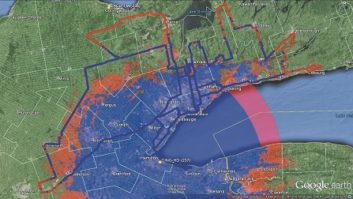I have suggestions for the proposed 76 to 87.7 MHz band (“Could EXB Band Be Your New Home,” Sept. 10).
I would use Digital Radio Mondiale (DRM), and not DRM+, in the new band. I would break each channel into five 20 kHz wide sub-channels that would each have a maximum of 72.0 kbps, 64-QAM and a minimum of 30.6 kbps, 16-QAM, so the broadcaster would have the option of having up to five different programs at once.
Each broadcaster should also have the option of linking any or all of these sub-channels together so the maximum bit rate would range from 153 kbps to 360 kbps with all sub-channels linked.
Let me show you what this would look like for an AM station that moves to the new band. I use AM 1230 in Waco, Texas, for a hypothetical example. The station would move to, let’s say, 83.9 MHz and would in the first hypothetical example use five channels separately.
- 83.85–83.87 Tech news only (in my dreams)
- 83.87–83.89 News only
- 83.89–83.91 Programming from AM 1230 (talk shows)
- 83.91–83.93 Left-wing talk (for example)
- 83.93–83.95 Big band & standards music (another dream)
In my second hypothetical example, two stereo programs and one mono program are broadcast:
- 83.85–83.87 Right-channel program A (guitar music)
- 83.87–83.89 Left-channel program B (piano music)
- 83.89–83.91 Programming from AM 1230 (talk shows)
- 83.91–83.93 Right-channel program B (piano music)
- 83.93–83.95 Left-channel program A (guitar music)
In my final example the broadcaster chooses to link all sub-channels together for maximum bit rate for best audio quality and therefore no list of sub-channels is needed.
The system needs to have the details worked out.
There should be an option for iBiquity’s digital system as an option only, never a requirement because I believe that no broadcaster who has received an FCC license to broadcast should have to pay iBiquity thousands of dollars before being able to broadcast.
James Johnson
Arlington, Texas












